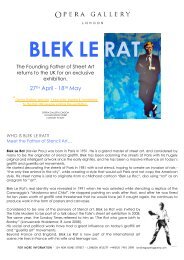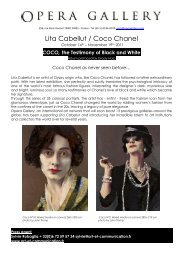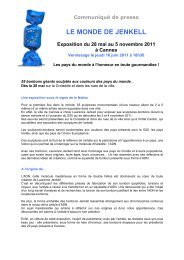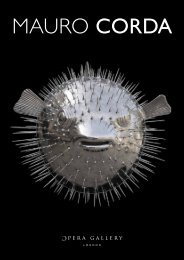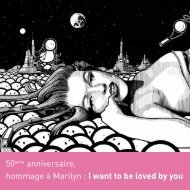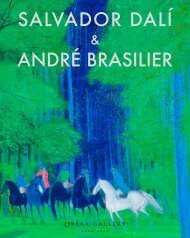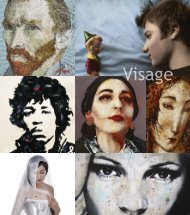the testimony of black and white - Opera Gallery
the testimony of black and white - Opera Gallery
the testimony of black and white - Opera Gallery
You also want an ePaper? Increase the reach of your titles
YUMPU automatically turns print PDFs into web optimized ePapers that Google loves.
COCO AND CABELLUT<br />
by Grady Harp<br />
“In order to be irreplaceable one must always be different.”<br />
Coco Chanel<br />
There are many parallels between <strong>the</strong> lives <strong>of</strong> empress <strong>of</strong> fashion, Coco Chanel,<br />
<strong>and</strong> <strong>the</strong> expressionist artist Lita Cabellut. Both women began <strong>the</strong>ir lives in<br />
poverty, both found a core <strong>of</strong> expression that raised <strong>the</strong> stature <strong>of</strong> <strong>the</strong> feminine<br />
mystique, both fearlessly confronted a world in <strong>the</strong> arts controlled by men <strong>and</strong><br />
inexorably changed that vantage with <strong>the</strong>ir own style <strong>and</strong> temerity: both are<br />
exceptional voices in <strong>the</strong>ir chosen expressive fields. Though <strong>the</strong> words may be<br />
Chanel’s, <strong>the</strong>y could as easily be Cabellut’s – “My life didn’t please me, so I created<br />
my life”.<br />
Lita Cabellut is a painter <strong>and</strong> a conjurer. Her paintings capture that interior<br />
mysterious space within <strong>the</strong> minds <strong>of</strong> her subjects, a complex brew <strong>of</strong> imagination<br />
<strong>and</strong> <strong>the</strong> compulsion to deal with occult dreams <strong>and</strong> longings as well as<br />
<strong>the</strong> terror <strong>and</strong> fragility <strong>of</strong> <strong>the</strong> human condition. Her genius lies in her ability<br />
to make visible <strong>the</strong> invisible: passion pours forth from her large-scale portraits<br />
that dem<strong>and</strong> our attention <strong>and</strong> invite us into <strong>the</strong> process <strong>of</strong> her creative mind.<br />
Cabellut is a Spanish painter, born a gypsy in <strong>the</strong> earthy streets <strong>of</strong> Barcelona,<br />
her fa<strong>the</strong>r unknown, deserted by her prostitute mo<strong>the</strong>r at <strong>the</strong> tender age <strong>of</strong><br />
three months, nurtured by her gr<strong>and</strong>mo<strong>the</strong>r who sequestered her as a gypsy<br />
from schools until her death. Cabellut at age eight was placed in an orphanage.<br />
Hungry for knowledge, she spent her hours at <strong>the</strong> Prado Museum, drinking<br />
deeply <strong>the</strong> works <strong>of</strong> <strong>the</strong> masters <strong>of</strong> <strong>the</strong> past – Rembr<strong>and</strong>t, Velázquez, El Greco,<br />
Ribera, Gallego <strong>and</strong> Goya. Once accepted into school, she rapidly rose through<br />
<strong>the</strong> ranks <strong>of</strong> education, ultimately being accepted into <strong>the</strong> Fine Arts School in<br />
Amsterdam, where instead <strong>of</strong> embracing <strong>the</strong> current obsession with abstract<br />
art, she connected with Francis Bacon’s tortured figurative paintings <strong>and</strong> fellow<br />
Catalan artist Antoni Tàpies’ abstract expressionism, with an emphasis on his<br />
pintura matérica – incorporating mixed media such as detritus, earth, rags <strong>and</strong><br />
stone into his paintings.<br />
Cabellut’s works serve as a bridge between classical tradition <strong>and</strong> contemporary<br />
painting, a bridge from which she creates faces <strong>and</strong> figures from <strong>the</strong> past,<br />
infusing her own history as a street gypsy into underst<strong>and</strong>ing <strong>the</strong> beginnings<br />
<strong>of</strong> <strong>the</strong> focused model she brings to life in this collection – Gabrielle ‘Coco’ Chanel.<br />
From her own experiences, <strong>the</strong> artist is able to see through <strong>the</strong> eyes <strong>and</strong><br />
cautious stares <strong>of</strong> her subjects, <strong>and</strong> to engage her audience with a sense <strong>of</strong> challenge<br />
mixed carefully with compassion.<br />
The life <strong>of</strong> Coco Chanel (1883 -1971) has been <strong>the</strong> subject <strong>of</strong> many books, films<br />
<strong>and</strong> plays: <strong>the</strong> details <strong>of</strong> her rise from her orphanage years where she was raised<br />
by nuns who taught her <strong>the</strong> sewing skills that would lead to her life’s obsession<br />
for creating fashion, her fleeting experience as a singer in clubs where she<br />
earned her nickname ‘Coco’ (a name she insisted was derived from <strong>the</strong> word<br />
cocotte – or ‘kept woman’), her dalliance with Etienne Balsan who financed her<br />
move to Paris at age 26 to try her millinery ideas, <strong>and</strong> her affair with <strong>the</strong> wealthy<br />
Arthur ‘Boy’ Capel whose influence on her sense <strong>of</strong> fashion as well as on her<br />
heart led to <strong>the</strong> opening <strong>of</strong> her famous shop on Rue Cambon in 1910. Capel was<br />
killed in an automobile accident in 1919 <strong>and</strong> Coco continued to leave flowers at<br />
<strong>the</strong> site <strong>of</strong> <strong>the</strong> tragedy for years afterward.<br />
Coco Chanel will forever be remembered as <strong>the</strong> person who freed women’s<br />
clothing from confining corsets, introduced <strong>the</strong> simple comfort <strong>of</strong> fashion<br />
influenced by men’s wear, created <strong>the</strong> 1920’s little <strong>black</strong> dress <strong>and</strong> added <strong>the</strong><br />
innovative concept <strong>of</strong> her own designer perfume as an accessory. She found<br />
acceptance in <strong>the</strong> world <strong>of</strong> fine art as <strong>the</strong> costume designer for Les Ballets Russes<br />
(Chanel created <strong>the</strong> costumes for <strong>the</strong> Stravinsky <strong>and</strong> Balanchine L’Apollon<br />
Musagète <strong>and</strong> <strong>the</strong> Milhaud, Nijinska, Cocteau <strong>and</strong> Picasso ballet Le Train Bleu)<br />
<strong>and</strong> became friends with <strong>the</strong> likes <strong>of</strong> Picasso, Dalí, Diaghilev, Cocteau, <strong>and</strong><br />
Stravinsky (ano<strong>the</strong>r passing affair). In 1925 she began a love affair with <strong>the</strong><br />
wealthiest man in Europe, Hugh Grosvenor, Duke <strong>of</strong> Westminster, who lavished<br />
her with jewels <strong>and</strong> gifts but who failed to make her his wife. At <strong>the</strong> peak<br />
<strong>of</strong> her influence, she created <strong>the</strong> legendary Chanel suit <strong>and</strong> <strong>the</strong> look that was<br />
unmistakably Coco Chanel, complete with her costume pearls <strong>and</strong> insistence<br />
on <strong>the</strong> subtlety <strong>of</strong> a monochromatic palette. World War II led to <strong>the</strong> closure <strong>of</strong><br />
her shop in part due to <strong>the</strong> German occupation <strong>of</strong> France <strong>and</strong> <strong>the</strong> subsequent<br />
controversies that followed.<br />
But with <strong>the</strong> resolution <strong>of</strong> <strong>the</strong> adverse effects <strong>of</strong> World War II, Coco Chanel once<br />
again forged a new life with her mid-fifties return to <strong>the</strong> fashion industry; even<br />
in <strong>the</strong> face <strong>of</strong> negative reviews from critics, she still appealed to women around<br />
<strong>the</strong> world with her fashionable <strong>and</strong> feminine, comfortable <strong>and</strong> subtly sensuous<br />
designs.<br />
Despite her numerous affairs with a variety <strong>of</strong> men (some would say she<br />
used men, but she took from each <strong>of</strong> <strong>the</strong>m inspiration that would increase her<br />
knowledge <strong>and</strong> repertoire), Coco Chanel never married – “It’s probably not just<br />
by chance that I’m alone. It would be very hard for a man to live with me, unless he’s<br />
terribly strong. And if he’s stronger than I, I’m <strong>the</strong> one who can’t live with him… I’m<br />
nei<strong>the</strong>r smart nor stupid, but I don’t think I’m a run-<strong>of</strong>-<strong>the</strong>-mill person. I’ve been in<br />
business without being a businesswoman; I’ve loved without being a woman made only<br />
for love. The two men I’ve loved, I think, will remember me, on earth or in heaven,<br />
because men always remember a woman who caused <strong>the</strong>m concern <strong>and</strong> uneasiness.<br />
I’ve done my best, in regard to people <strong>and</strong> to life, without precepts, but with a taste for<br />
justice”. And fur<strong>the</strong>r, “I never wanted to weigh more heavily on a man than a bird”.<br />
She died in 1971, but her legend lives on – in influencing fashion, in her role as<br />
a feminist, in her instinctive sense <strong>of</strong> style, <strong>and</strong> as a woman who changed <strong>the</strong><br />
world in her own way. “Fashion is not simply a matter <strong>of</strong> clo<strong>the</strong>s.” “Fashion is in<br />
<strong>the</strong> air, borne upon <strong>the</strong> wind. One intuits it. It is in <strong>the</strong> sky <strong>and</strong> on <strong>the</strong> road.” “Fashion<br />
passes, style remains.”<br />
Lita Cabellut <strong>of</strong>fers us her responses to <strong>the</strong> history <strong>of</strong> Coco Chanel with her<br />
large scale portraits <strong>of</strong> <strong>the</strong> fashion icon as well as some images <strong>of</strong> Chanel’s models.<br />
She heeds <strong>the</strong> icon’s rules <strong>of</strong> monochromaticity not only in <strong>the</strong> fashions<br />
she paints but also in <strong>the</strong> variations <strong>of</strong> grey as <strong>the</strong> matrix for each work. In<br />
titling this exhibition Coco: The Testimony <strong>of</strong> Black <strong>and</strong> White she echoes <strong>the</strong><br />
thoughts <strong>of</strong> Renaissance artist, poet <strong>and</strong> architect Leon Battista Alberti: “I would<br />
have artists be convinced that <strong>the</strong> supreme skill <strong>and</strong> art in painting consists in knowing<br />
how to use <strong>black</strong> <strong>and</strong> <strong>white</strong>...because it is light <strong>and</strong> shade that make objects appear in<br />
relief”. Some <strong>of</strong> <strong>the</strong> paintings follow a chronological order: Coco as a young girl<br />
in simpler, reflective garb; Coco growing into her new concepts; <strong>the</strong> ultimate,<br />
complete Coco with str<strong>and</strong>s <strong>of</strong> costume pearls <strong>and</strong> hats <strong>and</strong> accoutrements. And<br />
in each <strong>of</strong> <strong>the</strong>se visits with <strong>the</strong> spirit <strong>of</strong> Coco Chanel, Cabellut seems to channel<br />
all <strong>the</strong> emotion, drive <strong>and</strong> control <strong>of</strong> a woman who would alter <strong>the</strong> world in<br />
her unique way. Cabellut’s uncanny method <strong>of</strong> capturing <strong>the</strong> direct gaze <strong>of</strong> <strong>the</strong><br />
Coco in her paintings as she peers at <strong>the</strong> viewer, while revealing <strong>the</strong> symbiosis<br />
<strong>of</strong> <strong>the</strong> fragility <strong>and</strong> strength that so characterized her controversial life, is one<br />
reason <strong>the</strong>se paintings are so powerful. She brings to <strong>the</strong> canvas her perception<br />
<strong>of</strong> <strong>the</strong> Coco who is “queen <strong>of</strong> <strong>the</strong> Moon, <strong>black</strong>, <strong>white</strong>, sharp <strong>and</strong> far away”.<br />
Compare <strong>the</strong> ‘informed innocence’ <strong>of</strong> Coco numéro 3 with <strong>the</strong> successful gr<strong>and</strong>eur<br />
<strong>of</strong> Coco numéro 2, <strong>and</strong> numéro 14 with <strong>the</strong> mysterious, near masculine Coco<br />
numéro 6 - <strong>the</strong> portraits with dark glasses <strong>and</strong> averted glance pondering <strong>the</strong> fear<br />
<strong>of</strong> something that is hidden - <strong>and</strong> <strong>the</strong> virtuosity <strong>of</strong> Lita Cabellut is dramatically<br />
impressive. Just as Coco Chanel built her fashions, so Lita Cabellut builds her<br />
paintings. Working on large-scale canvases with oil <strong>and</strong> plaster on linen, she<br />
combines <strong>the</strong> visceral surface texture with passionate brushstrokes, a painterly<br />
technique that aims for emotional release instead <strong>of</strong> precise re-creation. It is this<br />
approach to expressing <strong>the</strong> inner character that she brings to life.<br />
It would be difficult indeed to imagine any o<strong>the</strong>r artist with as much access to<br />
<strong>the</strong> emotional life <strong>of</strong> Coco Chanel as Lita Cabellut. The artist honors <strong>the</strong> fashion<br />
gifts <strong>of</strong> <strong>the</strong> iconic figure <strong>of</strong> Coco Chanel but she doesn’t stop at surface appearances,<br />
just as Chanel’s inspirations came from intrinsic responses to her ab<strong>and</strong>onment<br />
as a child, her courage to overcome <strong>the</strong> fashion concepts <strong>of</strong> her day,<br />
her balance between <strong>the</strong> fragility <strong>of</strong> her affairs <strong>and</strong> her determination to belong<br />
to no one, her transient defeat in <strong>the</strong> eyes <strong>of</strong> her public to her resurgence as one<br />
<strong>of</strong> history’s most important women <strong>of</strong> business <strong>and</strong> <strong>of</strong> style. The Coco Chanel<br />
presented in this collection is a brew <strong>of</strong> <strong>the</strong> artist’s insight, similar life experiences<br />
<strong>and</strong> technical facility; this is what makes <strong>the</strong>se magnificent paintings so<br />
substantial, so thrilling, so rich in psychological impact. In Coco’s words: “Arrogance<br />
is in everything I do. It is in my gestures, <strong>the</strong> harshness <strong>of</strong> my voice, in <strong>the</strong> glow<br />
<strong>of</strong> my gaze, in my sinewy, tormented face”.<br />
“Women think <strong>of</strong> all colors except <strong>the</strong> absence <strong>of</strong> color. I have said that <strong>black</strong> has it all.<br />
White too. Their beauty is absolute. It is <strong>the</strong> perfect harmony.”<br />
Coco Chanel<br />
Grady Harp is a champion <strong>of</strong> Representational Art in <strong>the</strong> roles <strong>of</strong> curator, lecturer, panelist, writer <strong>of</strong> art essays, poetry, critical reviews <strong>of</strong> literature, art <strong>and</strong> music, <strong>and</strong> gallerist. He has produced exhibitions<br />
<strong>and</strong> written to catalogue essays for <strong>the</strong> Arnot Art Museum in New York, <strong>the</strong> Fresno Museum <strong>of</strong> Art, <strong>the</strong> Laguna College <strong>of</strong> Art <strong>and</strong> Design, <strong>the</strong> Nevada Museum <strong>of</strong> Art, <strong>the</strong> National Vietnam Veterans Art<br />
Museum in Chicago, <strong>and</strong> <strong>the</strong> Clevel<strong>and</strong> State University Art <strong>Gallery</strong>; Grady has served as a contributing artistic advisor for universities <strong>and</strong> colleges throughout California, in Berlin, in Madrid for <strong>the</strong> Centro<br />
Cultural de Conde Duque, <strong>and</strong> in Oslo. His collaborative exhibition with sculptor Stephen Freedman, WAR SONGS: Metaphors in Clay <strong>and</strong> Poetry from <strong>the</strong> Vietnam Experience toured <strong>the</strong> United States from 1996<br />
to 1998. He has provided prefaces, chapters <strong>and</strong> essays for numerous books such as <strong>the</strong> recent Powerfully Beautiful <strong>and</strong> 100 Artists <strong>of</strong> <strong>the</strong> Male Figure. He is <strong>the</strong> art critic for Poets & Artists magazine <strong>and</strong> <strong>the</strong> art<br />
historian for The Art <strong>of</strong> Man Quarterly Journal.



